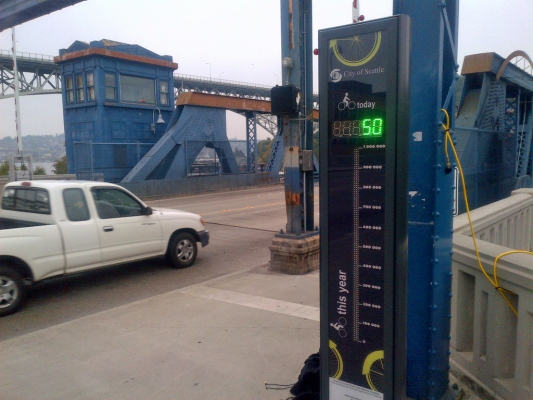Research evaluates methods for estimating bicycle and pedestrian miles traveled

Vehicle miles traveled, or VMT, is a standard indicator of how many vehicles use a roadway system. A similar metric for bicycles and pedestrians is needed in order to achieve livability goals. Such data can inform decision-making, facility design and planning, and safety analysis.
A NITC report from Portland State University evaluates three methods of calculating bicycle miles traveled (BMT) and pedestrian miles traveled (PMT) by applying them to Washington State.
The Washington State Pedestrian and Bicycle Miles Traveled Project was led by Krista Nordback, a former TREC research associate who is now a senior research associate at the University of North Carolina's Highway Safety Research Center.
The researchers used data from permanent counters when available; otherwise they used short-duration counts to extrapolate average annual daily bicycle and pedestrian traffic.
When the project began in 2012, only one permanent count site existed in Washington, and it only counted bicycles. Nordback’s team contacted state officials to advise that more counters would be helpful; the state listened and installed more counters. Now there are more than a dozen permanent bicycle and pedestrian counters scattered throughout Washington.
Nordback’s team investigated a survey-based method, a sample-based method, and an aggregate demand model.
Because of data limitations, none of these methods could be properly implemented on the statewide level. So to compare findings, the team implemented all three methods in King County, which includes the Seattle metropolitan area.
The travel survey method estimated the lowest BMT and PMT, and the sample-based method estimated the highest.
Gauging accuracy is difficult, because the actual values of BMT and PMT are unknown. However, in the course of the project, researchers uncovered some useful information that could help compute these metrics in the future.
“The sample based method is great if you're looking at the facility level, but when we look at the state level, short duration counts tend to be biased towards high count locations,” Nordback said.
The aggregate demand model is useful because it takes into account demographic factors, which are especially good for predicting pedestrian behavior. For bikes, the sample-based method may be more appropriate.
The travel survey method is most useful for the city or state level, and does not offer facility-level details.
For future work, Nordback recommends expanding this research by improving count programs, including a larger sample in the travel survey, and integrating other data sources such as GPS apps.
For a more detailed look at this research, visit the project page or download the final report.
Nordback also gave a webinar on this research in December; a recording and slides are available here.
